Arretium › Empuries » Ancient origins
Articles and Definitions › Contents
- Arretium › Antique Origins
- Empuries › Ancient History
Ancient civilizations › Historical and archaeological sites
Arretium › Antique Origins
Definition and Origins
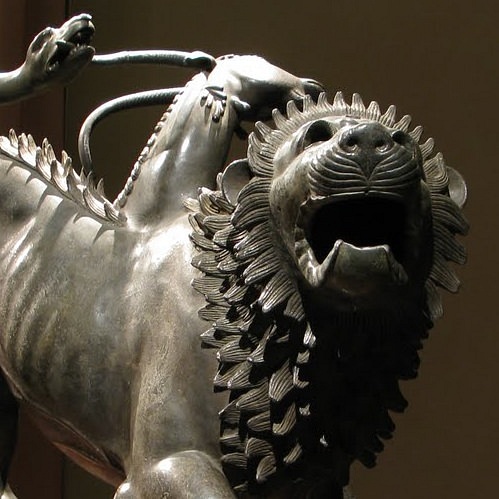
Arretium (modern Arezzo) was an important Etruscan town located in the extreme north-east of Etruria in central Italy. Flourishing as a trade and manufacturing centre, Arretium managed to overcome its rivalry with Rome and continue as a prosperous town into the Imperial period. Although much of its ancient architecture has disappeared, one significant legacy from the Etruscan period is the magnificent bronze statue known as the Chimera of Arezzo, perhaps that culture's finest surviving art piece.
EARLY SETTLEMENT
Although human habitation of the site dates back to the Palaeolithic Period, Arretium was something of a late starter compared to other Etruscan sites which sprang up in the Villanovan Period (1100-750 BCE). Etruscan Arretium was established, rather, sometime in the 6th century BCE. Arretium prospered due to its geographical location at the junction of the Tiber River and Arno River valleys. The settlement was also situated near a break in the Apennine Mountains giving access for wider Etruria to the Adriatic coastal region of eastern Italy.
ETRUSCAN ARRETIUM
Prospering as a trading hub, the town also manufactured its own goods, particularly bronze works, pottery, and terracotta statues. The artists of Arretium produced perhaps the finest single surviving Etruscan artwork, the 'Chimera of Arezzo.' This 5th-4th-century BCE representation of the mythical part-lion part-goat part-snake creature, exquisitely cast in bronze, was miraculously found in a ditch in 1553 CE when new fortifications were being raised by Cosimo de' Medici, the Grand Duke of Tuscany. It now takes pride of place in the National Archaeological Museum of Florence.
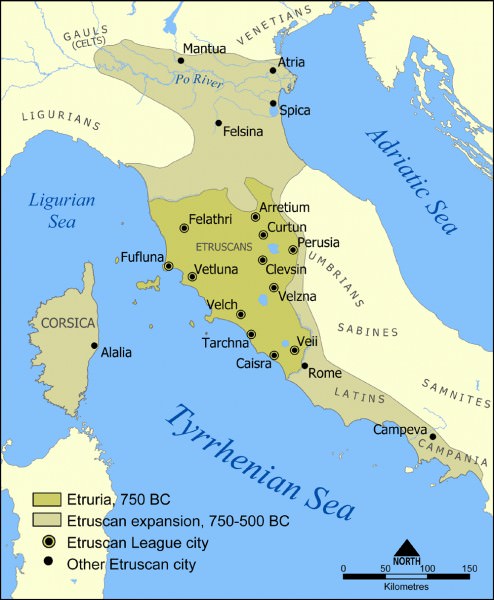
Etruscan Civilization
RELATIONS WITH ROME
Arretium had a troubled relationship with her powerful neighbour Rome. According to Dionysius of Halicarnassus, the town sided with the Latins during the 6th century BCE in their battles with the Roman king Tarquinius Priscus. Illustrating the ambiguous nature of Etruscan-Roman relations over the centuries, the Roman historian Livy states that Rome actually helped Arretium in 302 BCE, or at least its ruling aristocracy. The dominant Cilnii clan faced a popular uprising from an increasingly disillusioned lower class and called in Rome for help. A Roman force was sent but was attacked and badly mauled in an ambush. A second larger force, led by the dictator Marcus Valerius Maximus, swiftly restored order. Rome was beginning to show an alarming interest in Etruscan affairs.
Rusellae (modern Roselle) was sacked in 294 BCE, a stark warning of the futility of opposing Rome. According to Livy, the Etruscan towns of Volsinii, Perusia, and Arretium then negotiated a peace with Rome. The price for a 40-year truce was a huge 500,000 asses per city. The truce did not last very long as, in 284 BCE, Volsinii took advantage of an invading army of Gauls to join them and attack Arretium, then loyal to Rome. A relieving Roman army was defeated, but the next year the Romans, led by P. Cornelius Dolabella, won a decisive victory at the Battle of Lake Vadimo.

Minerva of Arezzo
During the latter half of the 3rd century BCE, Arretium was also attacked by Carthage. However, the city was an ally (albeit a passive one) of Hannibal during his attacks in Italy during the Second Punic War (218-201 BCE), despite previously promising loyalty to Rome and often acting as an important Roman base from which to launch attacks in northern Italy. In the complex and delicate situation of a foreign army in Italy and Etruscan cities of dubious allegiance, Rome attempted to ensure greater loyalty by taking a number of hostages from Arretium's ruling families. When the Romans won victory over Carthage, Arretium's lack of support was not forgotten and the city was made to pay compensation by way of thousands of pieces of bronze weapons and armour.
Arretium then seems to have settled down as a minor town within the burgeoning Roman empire. In the 2nd century BCE, part of its territory was redistributed to Roman veterans, but it did benefit from being the first stopping point on the via Cassiawhich went from Rome and crossed the Apennines to Aquileia. In the early 1st century BCE Arretium was made a municipium. The city then made the fateful decision to back the wrong side in Rome's civil war, supporting Gaius Marius. The victor, Sulla, made a colony and resettled his veterans at Arretium in 80 BCE; Julius Caesar was to do exactly the same before the century was out.
Having got over its initial problems with Rome's expansion, Arretium became a relatively prosperous Roman town in the early Imperial period, no doubt helped by the fact that Emperor Augustus' great confidant, Gaius Maecenas, was a native of Arretium. Benefits included construction of an amphitheatre, theatre, forum, and Roman baths. The town also became noted as a major production centre for the Arretina terra sigillata pottery with its distinctive coral colour and which was exported widely throughout the Roman world. The town gradually slipped into obscurity from the 2nd century CE when Trajan made the decision to connect the via Cassia directly to Florentia (Florence), thus bypassing Arretium and robbing it of its commercial traffic. The town would regain some of its former glory in the late Middle Ages, though, when it became an independent city-state once again.
ARCHAEOLOGICAL REMAINS
As with other Etruscan towns that have since been built over in medieval times and which continued to be occupied today, the archaeology of ancient Arretium has met with difficulties. There are traces of fortification walls from the period. Two Etruscan sanctuaries on the outskirts of Arretium are indicated by the presence of votive offerings. One, the Fonte Veneziana (named after a fountain near one of the city gates), had some 200 items in a votive pit. They included bronze figurines of humans and animals (some with gold leaf decoration), pottery vessels, and anatomical plaques of eyes, arms, legs, and busts. The second deposit at Monti Falterona was a lake in use between the 6th and 3rd century BCE where offerings were thrown in such as arrow heads, nuggets of bronze, pottery fragments, and bronze figurines. Fine examples of the latter category are a bronze male head and a warrior statuette, both are now in the British Museum, London.

The Arringatore (Orator)
From the Roman period, there are remains of pottery workshops and some private housing. In addition, there is a lower course and several arches of the Roman amphitheatre still in situ, which gives an idea of the outline of the building.
Besides the magnificent Chimera already mentioned, other fine bronze statues are the 'Minerva of Arezzo' (3rd-1st century BCE), a 4th-century BCE statuette of two oxen and a ploughman, and a 1st-century BCE lifesize figure known as the Arringatore or 'Orator.' The latter work was discovered near Lake Trasimene in 1566 CE. The confident figure with arm raised in appeal and wearing a toga is perhaps the answer to the frequently asked question 'what became of the Etruscans?': they became Romans.
MAP
Empuries › Ancient History
Definition and Origins
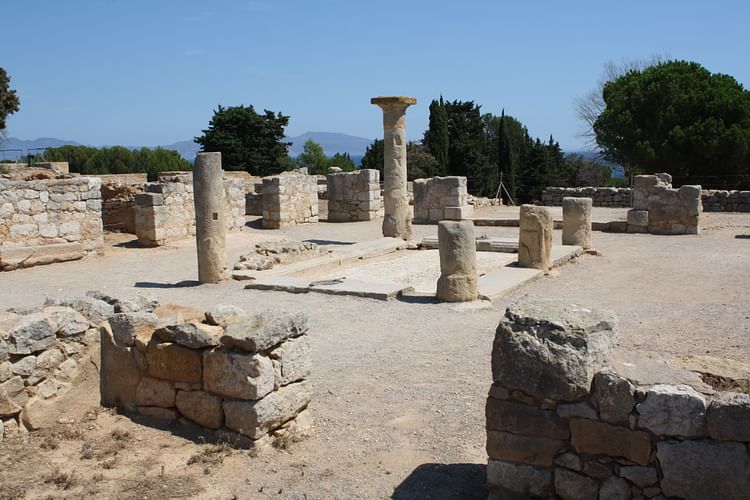
Empuries (also Emporiae or Emporion) was a Greek and then Roman colony on the northeastern coast of Spain. Thriving as a local and Mediterranean trading centre, it prospered from the 6th century BCE to the 2nd century CE. Several times the Romans used the port as a landing place for armies to invade and plunder Iberia and they established a military camp at the site which evolved into a small town embellished with the usual collection of Roman architectural features. The site today offers the visitor extensive ruins, notably a large portion of the city walls, a crytpoportico, forum space, and large private houses.
HISTORICAL OVERVIEW
Empuries was established by settlers from Massalia (Marseilles) in the 6th century BCE who founded the port of Palaeopolis on an island at the mouth of the Fluvia River. The settlers prospered through trade and then spread to the Greek town known as Neapolis near the coast which covers about 4 hectares. The two areas were called Emporion, indicative of their dependence on trade, where wine, pottery, and olive oil, along with goods from Massalia and those of Etruscan origin, were exchanged for metals and foodstuffs from the local tribes reached via the River Fluvia and the nearby River Ter.
FROM 100 BCE, THE ROMANS, EAGER TO EXPLOIT IBERIA, BUILT A NEW TOWN OVER THEIR ORIGINAL ARMY CAMP.
The Romans used the port during the Second Punic War against Carthage, with Scipio Africanus landing expeditions there in 218 and 211 BCE, and again in 195 BCE when Marcus Porcius Cato led a force to quash the Iberian revolt which sprang up in reaction to Rome’s demands for tribute. From 100 BCE, in order to create a more permanent base from which to exploit Iberia and protect the trade route from Italy, they built a Roman town from the original army camp. Located on the coast opposite from the Greek town, which had by then covered all of the island, the Roman town was laid out in right-angled blocks and eventually spread to cover some 22.5 hectares. The town received another boost when Julius Caesarsettled veterans from his legions there in 45 BCE.
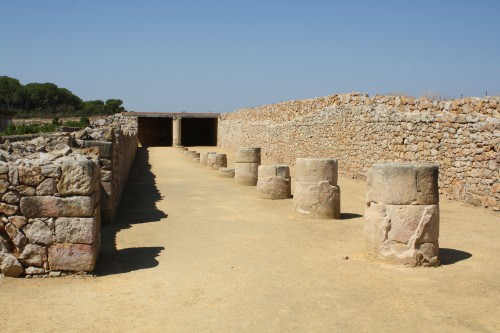
Cryptoportico, Empuries
In the reign of Augustus (27 BCE – 14 CE) the two still separate towns and a nearby indigenous Iberian settlement (Indika) were combined and awarded the status of municipium, which was given the collective name Emporiae. The town had its own forum, agora, small amphitheatre, gymnasium, and walls, and continued to mint its own coinage(which began in the 5th century BCE) with a characteristic Pegasus design. There were also temples to the Greek god of medicine Asclepius and to Serapis, the Hellenistic-Egyptian god. Empuries declined in importance for unknown reasons from the 2nd century CE but continued as a more modest, walled settlement well into the early Christian period.
ARCHITECTURAL HIGHLIGHTS
The site of the indigenous settlement Indika has yet to be located, but pottery finds suggest the area was first inhabited from the 9th century BCE, and large grain silos are evidence of the trade which went on with their Greek and Roman neighbours. The majority of the architectural remains in the Greek quarter of Empuries (the Neapolis area) belong to the Hellenistic Period and date to the 2nd and 1st centuries BCE, although some of the lower courses of the 4th century BCE fortification wall survive. The majority of the Roman town remains unexcavated and the structures which can be seen today date from the 1st century BCE to the 1st century CE.

Ground Water Filter, Empuries
Neapolis
Here are the remains of various temples and sanctuaries, notably that dedicated to Asclepius, the Greek god of medicine and healing. This dates to the 4th-2nd century BCE and its large calcareous stone podium is still visible today. Here too is an unusual ceramic water filter set into the ground and a large cistern, both dating to the Hellenistic period when the sanctuary was remodelled. The foundations of the agora (50 x 40 metres) and stoa (50 x 14 metres), originally with a 12-column façade, are still visible, as are a single large public cistern and three smaller ones, to give an impression of these places where the people of Empuries met and shopped. There are also the foundations and two short staircases of the 1st-century BCE templededicated to Isis and Zeus Serapis. There are remains of modest one and two-roomed houses, probably used by traders and the small workshops (tabernae) of craftsmen. A few other homes are larger residences with colonnaded courtyards which include water-collecting drains and one residence with a hall for symposia, as indicated by the Greek ΗΔΘΚΟΙΤΟΣ (‘how sweet to be reclined’) laid out on the mosaic flooring. Finally, by the agora are the remains of the 4th-century CE early Christian church and cemetery with several stone sarcophagi left in situ. The cemetery was in use up to the 9th century CE and held over 500 tombs of all social classes.
Roman Forum
The Republic-era forum space had a temple (most probably dedicated to Jupiter, Juno, and Minerva) with a front portico of four columns. The open area, paved with sandstone slabs, was enclosed on three sides by a double-colonnaded building with a cryptoportico beneath it. A portion of the latter structure has had its roof reconstructed to give an idea of how it originally looked. The forum was revamped in the Augustan period, and the main temple became enclosed behind a low wall to restrict the sacred area. At least one new temple was dedicated to the imperial cult, and a basilica was built for the city’s administrators.

Mosaic Flooring, Empuries
Roman Domus
Portions of the columned atrium of the late-Republic house (domus) no. 1 survive, including a drain to collect water into the two cisterns below. The house is typical of large Roman private houses but is built on two terraces to compensate for the uneven terrain. The many rooms, courtyards, and garden areas include a small three-roomed thermal complex or balneum. The domus also has a number of impressive and well-preserved black and white mosaic floors.
Roman City Gates & Wall
A significant stretch of the Roman city walls survives on the south side. Built from the 1st century BCE and probably initially part of the Roman fortified camp, the walls were constructed using several courses of large polygonal blocks and an upper section of concrete (opus caementicium). Also surviving are two city gates with the portion of stone roadway beneath one showing the wear of wheeled traffic. To the sides of these gates is a phallus carved into one of the stone blocks as a protective symbol.
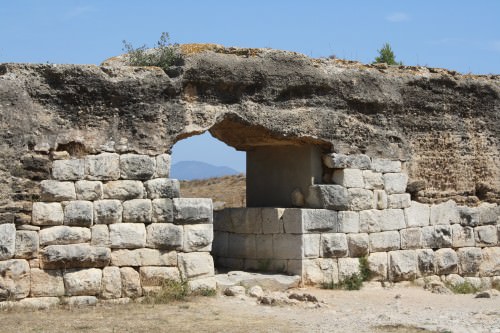
City Gate, Empuries
ARCHAEOLOGICAL FINDS
With three settlements and many more cemeteries, Empuries has a rich offering in art and everyday objects. The most impressive archaeological discovery was undoubtedly a larger-than-life statue of Asclepius. The figure, once abandoned in a cistern, combines both Pentelic and Parian marble and dates to the 4th century BCE. The statue once stood in a small sanctuary dedicated to the god. Other interesting finds, also on display in the site museum include a 5th-century BCE commercial letter written in Greek on a sheet of lead, local Iberian pottery with geometric decoration, Etruscan black glaze pottery, an Iberian sandstone stele (6th century BCE) carved with a spiral to represent a bent spear, and an altar from the peristyle of a Roman villa decorated with painted scenes. Finally, several fine emblemata mosaics survive from the large villas at the site including a detailed depiction of the sacrifice of Iphigenia from Greek mythology.
LICENSE:
Article based on information obtained from these sources:with permission from the Website Ancient History Encyclopedia
Content is available under License Creative Commons: Attribution-NonCommercial-ShareAlike 3.0 Unported. CC-BY-NC-SA License